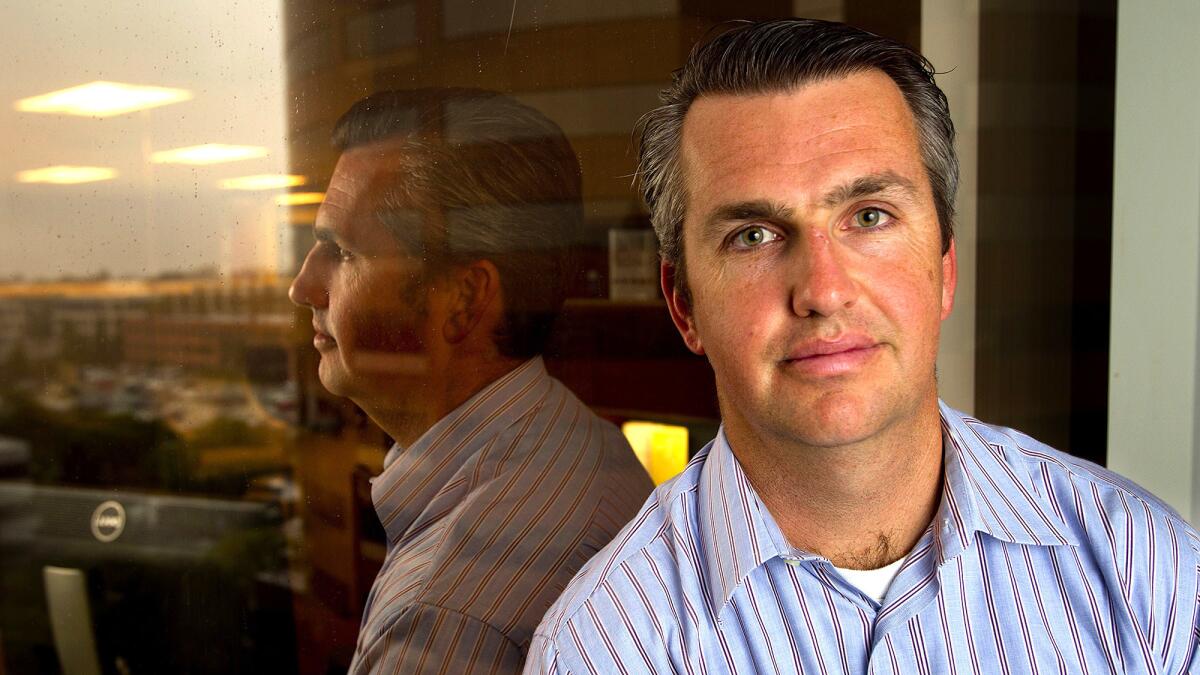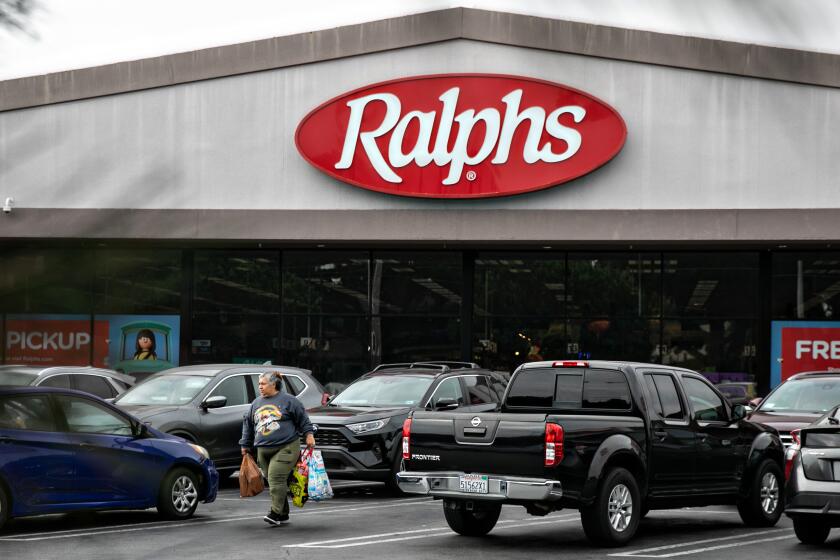Jamie Dimon made a bundle last year. San Diego banker Gregory Garrabrants earned even more

- Share via
Chief executives of Wall Street’s largest banks were awarded record pay packages last year as profits soared.
Nearly 2,500 miles away, the CEO of a little-known online lender, born at the height of the dot-com bubble, quietly out-earned them all.
His name is Gregory Garrabrants. As head of Axos Financial Inc. — formerly Bank of Internet USA — he made $34.5 million in 2018, more than even the princely sums that Jamie Dimon of JPMorgan Chase & Co. ($31 million) and Goldman Sachs Group Inc.’s David Solomon ($23 million) raked in. It’s all the more remarkable considering just how small the San Diego-based bank is. With $9.8 billion in assets, Axos is little more than a rounding error compared with JPMorgan’s $2.62 trillion.
So, how did Garrabrants make so much? And importantly, at a time when income inequality has become such a political flash point, did he deserve it?
The answer to the first question lies in a complex pay structure more commonly found at hedge funds, which wound up being far more lucrative than the bank predicted. As for the second question, it’s complicated. Some say it’s a fair outcome for a leader whose pay was directly tied to his firm’s hefty share gains. Others say it reflects short-term incentives gone wrong and an out-of-touch board beholden to its CEO. While Axos’ stock price shot up 72% last fiscal year, holders of nearly half those shares voted against the plan.
“There’s no requirement for the CEO to sustain performance,” John Roe, head of ISS Analytics, a unit of Institutional Shareholder Services Inc., says of Garrabrants’ package. Beat your target “big in year one and you’ve made it. You don’t have to worry anymore.”
Axos Chairman Paul Grinberg disagrees and says the compensation plan, which took effect in 2017, aligns the CEO’s interests with those of the bank’s shareholders over the long term. Moreover, the payout should be looked at “over the life of the plan,” which may fluctuate in value, rather than any for single year. He also pointed to Axos’ outsize share-price gains during Garrabrants’ tenure.
“It’s important to look at the company’s performance,” Grinberg said in an emailed statement to Bloomberg. Under Garrabrants, “Axos has been arguably the best-performing stock in the banking industry.”
Founded in 1999, Axos was a pioneer in online lending in the U.S. and still has no physical branches. The 47-year-old CEO, whose career has included stints at Goldman, McKinsey & Co. and mortgage originator IndyMac Bancorp Inc., has led the bank for over a decade. Since he took over in 2007, Axos’ assets have increased tenfold, fueled in part by providing esoteric loans that some other financial institutions avoided.
The growth hasn’t come without controversy. In 2015, a former internal auditor accused the bank of several compliance failures and improper related-party dealings, court filings show, which drew the attention of short sellers and sparked several shareholder lawsuits. The Securities and Exchange Commission investigated matters related to the bank’s internal controls and loans to foreigners, according to Probes Reporter. The agency concluded the probe in 2017 without taking action, and Axos has denied wrongdoing alleged by the ex-employee and shareholders.
It’s hard, though, to knock the CEO when it comes to boosting shareholder value. Axos shares have returned 1,657% since Garrabrants took the helm, far outstripping the 166% gain for small-cap stocks and the 65% advance for an index of community and regional banks.
In the summer of 2017, Axos struck a new contract — the one which triggered the huge payday in 2018 — with Garrabrants to keep him on the job for at least another five years. It was structured to tie his compensation more closely to the bank’s share-price performance, after some investors criticized his previous deal for failing to do so.
Here’s how it works. Each year, Garrabrants is eligible for a two-part stock award based on performance, in addition to his $700,000 salary.
The first part is somewhere between $2 million and $4.8 million per year, partially reflecting the board’s assessment of Garrabrants’ personal achievements. The second — and potentially more lucrative — part of the annual payout is based on Axos’ stock performance relative to an index of more than 300 community and regional banks.
In any year that Axos beats the index, Garrabrants gets 2% of the market-cap outperformance in dollars. It’s akin to carried interest reaped by general partners of hedge funds. (So, to oversimplify, if a company worth $100 million doubles in value and the index also doubles, the CEO gets nothing. If the company value doubles and the index stays flat, however, the CEO gets 2% of the entire $100-million increase in market cap, which in this case equals $2 million.)
On the other hand, if Axos’ return trails the index, the first part of his annual payout will be reduced or eliminated, and payouts for subsequent years may also decline if the underperformance is significant.
The plan raised more than a few red flags. Axos estimated that Garrabrants would get about $5 million in the first year. But Glass Lewis & Co. and ISS, which advise shareholders on how to vote at annual meetings, warned that the award could result in astronomical pay levels after a single year of big gains.
That’s exactly what happened. In the first year of Garrabrants’ new contract, which runs on fiscal years ending in June, Axos stock soared 72%, versus 11% for the benchmark. Based on Axos’ market-value increase, the CEO was awarded $32.3 million in shares and performance units. Add that to his $700,000 salary, $1.42 million bonus and $114,000 in perks, and you get to $34.5 million — almost twice as much Dimon’s take-home pay of $18.1 million and more than quadruple the amount Garrabrants got the previous year.
When asked about the plan, several big shareholders were taken aback by how Garrabrants’ compensation was structured and surprised by just how much he was actually paid. That includes Don Hankey, chairman of Hankey Group, which owns almost 6% of Axos.
“I would rate Greg Garrabrants a 9.9 on a scale of one to 10,” he said, “but this pay plan is way too lucrative.”
Hankey didn’t say how his firm voted on the plan.
To be fair, both the shares and the units will take several years to vest, which means their value could decline. Since the end of June, Axos has slumped 25%, more than twice as much as its performance benchmark.
Nevertheless, Keefe, Bruyette & Woods’ Michael Perito called the Garrabrants’ pay figure “bizarre” relative to the size of the bank. Among Axos’ closest rivals, CEOs on average took home a fraction of his haul. Put another way, if Dimon’s pay was structured the same way relative to the S&P 500 Financials Index, he would have been in line for some $400 million just on the stock-based performance portion alone.
“It was a direct result of a new compensation plan and dramatic share performance, which was almost a little artificial,” Perito said, adding Axos’ rally was inflated by short sellers buying back shares to limit their own losses.
That doesn’t mean there aren’t some vocal supporters.
John Trentacoste, chief operating officer at Farient Advisors, an executive compensation consulting firm, is one of them. In his view, Axos is simply getting singled out for trying something new. If anything, the plan puts the onus squarely on Garrabrants to perform. Do your job well and get paid big. Whiff and the consequences could last for years.
And as with all publicly traded companies, if shareholders dislike the way the CEO gets paid, there’s always an easy way out.
“If you don’t like it,” Trentacoste says, “don’t invest.”
More to Read
Inside the business of entertainment
The Wide Shot brings you news, analysis and insights on everything from streaming wars to production — and what it all means for the future.
You may occasionally receive promotional content from the Los Angeles Times.








